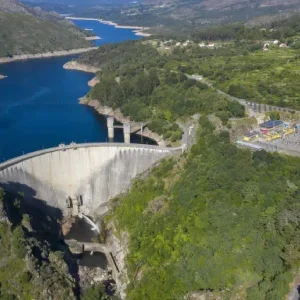Eight main-steam valve units are being supplied to China’s two V-320/VVER-1000 units, one for each of the four primary loops serving each reactor.
Each main-steam valve unit (see panel, right) consists of: a 580 mm (23 in), system-medium-operated, angle-type main-steam-isolation valve (MSIV); two main-steam safety valves (or steam generator safety valves) which operate sequentially; a quick-acting pressure-reducing valve; and an isolating valve upstream of the quick-acting, pressure-reducing valve.
The main-steam valve units are totally integrated to provide main-steam isolation and safety relief to atmosphere in the event of a failure upstream (towards a steam generator) or downstream (towards the steam turbine). The bodies of the safety and isolation valves are welded to the MSIV body to produce the most compact main-steam valve unit design. Each main-steam valve unit weighs about 16 000 kg (16.25 ton), with a floor area of only about 10 m2 (108 ft2).
Operation
During normal plant operation the MSIV is open. The force necessary to maintain this open position is provided by system pressure acting on the entire plug or piston diameter against the back disk seat. Since it is in firm contact with the backseat, there can be no leakage toward the drain. Two redundant solenoid-operated pilot-control valves, Nos 1 and 2, are energised and connect the upper piston chamber to the drain; one solenoid-operated pilot-control valve, No 3, is de-energised and connects the lower piston chamber to the drain.
In the event of a pipe rupture between the valve station and a steam generator, pilot-control valves Nos 1 and 2 allow full steam pressure to flow into the upper piston chamber, and the connection to the drain is closed. The MSIV then closes within five seconds. If a pipe rupture occurs between the valve station and the turbine, closing time is then only one second. As soon as the MSIV is in the closed position, pilot-control valve No 3 is energised, and the lower piston chamber is sealed off from the drain.
In the event of a power failure, pilot-control valves Nos 1 and 2 open and full steam pressure flows into the upper piston chamber, closing the MSIV. Since pilot-control valve No 3, of course, cannot be energised, there will remain a small, controlled leakage through the piston rings.
The isolation-relief valve and its pilot-control valve are closed in normal operation as well as the pilot-control valves serving the safety-relief valves. Full steam pressure, however, exists throughout the isolation-relief/safety-valve system.
Should the MSIV close in response to either an upstream or downstream pipe rupture or other system upset, the isolation-relief valve opens, venting steam pressure to the electro-mechanically actuated, quick-acting pressure relief valve. This valve remains partially open during normal operation, so that it can react immediately to the isolation-relief valve’s opening and control the venting of excess system pressure to atmosphere, thus holding system pressure to a preset level. If system pressure continues to rise beyond the capability of the pressure-relief valve to limit it to the preset level as required, the full-capacity safety valves open sequentially as needed and vent steam to the atmosphere to eliminate any adverse effects of higher-than-normal steam pressure on any of the secondary cycle components.






